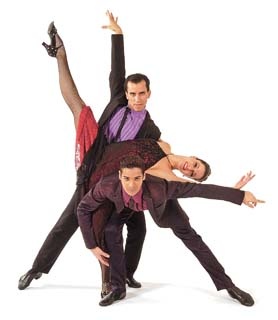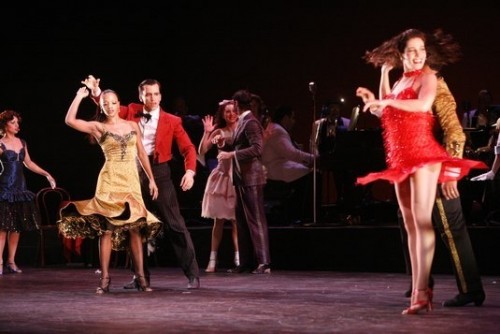Ballet Hispanico at Mass MoCA
Post season collaboration with Jacob's Pillow
By: Charles Giuliano - Oct 11, 2006
Palladium Nights
Featuring:
Afro-Latin Jazz Orchestra
With Arturo O'Farrill and Ballet Hispanico
www.ballethispanico.org
Arturo O'Farrill and Tina Ramirez, Artistic Directors
Choreography by Willie Rosario
Dramaturge by Edwin Sanchez
Set Design by Neil Patel
Costume Design by Emilio Sosa
Lighting Design by David Weiner
Ballet Hispanico:
Verdery Roosevelt, Executive Director
Derek Munson, General Manager
Gina Bugatti, Artistic Associate/Rehearsal Director
William Schaffner, Production Stage Manager
Mark Hankla, Lighting Director
Costumes by Grace Costumes, Timberlake Studios,
Juan Median Tailors, Arnold S. Levine, Inc.
Set Construction by John Creech Design
Afro-Latin Jazz Orchestra: Arturo O'Farrill, Music Director, Piano. Michael Philip Mossman, Trumpet, Darryl Shaw, Trumpet, Jim Seeley, Trumpet, Mike Rodriguez, Trumpet, Luis Bonilla, Trombone, Gary Valente, Trombone, Reynaldo Jorge, Trombone,
Douglas Purviance, Bass Trombone, Bobby Porcelli, Alto Saxophone, Erica Von Kleist, Alto Saxophone, Pablo Calogero, Baritone Saxophone, Mario Rivera, Tenor Saxophone,
Ivan Renta, Tenor Saxophone, Ruben Rodriguez, Bass, Vince Cherico, Drums
Jimmy Delgado, Percussion, Tony Rosa, Percussion
Characters: Mira (Angelica Burgos), Sparky (Waldemar Quinones Villanueva), Lola (Irene Hogarth-Cimino), Veronique (Candice Monet McCall), Antonio (Rodney Hamilton), Nina (Sara Kappraff), Casanova (Eric Rivera), Miss Chi Chi (Natalia Alonso), Woody (Iyun Harrison), Buster (Nicholas Villenueve), Hester (Kristine Covillo).
Act I:
Such Love, by Arturo O'Farrill: The Party Begins
Cuban Blues, by Chico O'Farrill: The Dance Lesson
3-D Mambo, by Tito Puente, arr. José Madera, Jr.
Trumpet Fantasy, by Chico O'Farrill: Veronique and Antonio's Nightclub Act
Tanga Bolero, by Mario Bauza, arr. Chico O'Farrill
Picadillo, by Tito Puente, arr. José Madera, Jr.: The Competition
Act II:
Chico and the Man, by Chico O'Farrill: The Night is Young
Guaguasi Empire, by Chico O'Farrill: Lola's Boys: Woody, Casanova, Buster, Sparky
Wild Jungle, Composed and arr. René Hernandez
Manteca, by Dizzy Gillespie and Chano Pozo, arr. Chico O'Farrill: A Mambo Jamboree
Pura Emocion, by Chico O'Farrill: A Love Duet
Sambia, by Mario Bauza, arr. Michael Mossman & Marcus Persiani
Pianarabatibiri, by Chico O'Farrill: Last Call
The Journey, by Chico O'Farrill: Sunrise
Para Los Rumberos, by Tito Puente, arr. Jose Madera, Jr.
As an encore of the regular summer season of Jacob's Pillow, the Berkshire based, internationally renowned dance institution collaborates with the Massachusetts Museum of Contemporary Art for one annual fall presentation. This past weekend the audience in Northern Berkshire county was treated to two superb evenings of sizzling dance by the Ballet Hispanico which was founded in 1970 by Tina Ramirez.
Following the performance which featured a series of short works displaying the diversity of the company and "Palladium Suite" a shortened version of "Palladium Nights" Ramirez was joined on stage by Pillow director, Ella Baff, for an informal chat about her origins as the daughter of a renowned bullfighter, the founding of the company and its complex mandate combining education and performance, as well as a discussion of the origin of the magnificent new work.
Ramirez, a small, thin woman with a closely cropped shock of gray hair, stated that she is "a dancer." This was punctuated by occasional bolting up from her chair to demonstrate steps and Latin timing which involves moving on the "two" the second rather than the first beat of a measure. It was riveting. Baff, on the other hand, stayed put. Ramirez described herself as first a dancer and secondly artistic director of the company,
She explained why in the past 36 years the company has commissioned choreographers to set some 70 plus works for Ballet Hispanico. She was particularly animated in relating how the newest piece, performed that evening to the stunned and mesmerized delight of the Mass MoCA capacity audience, evolved as a commission to do a work with a live orchestra as part of the Jazz at Lincoln Center series.
For a contemporary company that is a rare and stunning opportunity. But she related having difficulty matching a choreographer to a theme. The original choice for choreographer twice bowed out for other commitments and the initial theme of "Three Kings" failed to pan out. No matter as the piece "Palladium Nights" conceived by Ramirez, with the choreography of Willie Rosario, dramaturgy by Edwin Sanchez and the music of the Afro Latin Jazz Orchestra arranged and directed by pianist Arturo O'Farrill, son of the legendary Latin Jazz composer and performer, Chico O'Farrill, is a masterpiece and artistic triumph on every level. Caliente.
The evening started with a half hour of four short pieces featuring a solo "Batucada Fantastica" with Rodney Hamilton to music of Luciano Perrone, a quartet "Si Senor Es Mi" music of Gloria Estefan with Candice McCall, Eric Rivera, Angelica Nurgos and Lyun Harrison "Tito on Timbales" to music of Tito Puente with Nicholas Villeneuve and Kristen Covillo and "Cada Noche…Tango" a pas de trois with Natalia Alonso, Eric Rivera and Waldemar Quinones to music of Astro Piazzolla. These short works presented the range and discipline of the company and its particular focus on accent and rhythm as well as the element of story telling and drama. This latter aspect was particularly evident in the tempestuous, love triangle of Tango which provided an appropriate segue into the elaborate drama and narrative of the major work of the evening "Palladium Suite."
During the later question and answer period with the audience someone asked about Jerome Robbins and "West Side Story" as a possible source of inspiration for "Palladium." Ramirez answered "not really" while acknowledging the great contributions of Robbins and the impact of the Leonard Bernstein interpretation of "Romeo and Juliet" on Hispanic culture. But she described the influence of the famed New York ballroom and its influence on the Post War era as a leveling matrix of race and class and a place where people could break through the racism and segregation that dominated, and arguably still does, American popular culture.
What works best about "Palladium" is that it is a great example of narrative dance. In a sequence of twelve separate songs or arrangements of classic Latin Jazz pieces, mostly based on Chico O'Farrill originals, it sets forth a wonderful evening at the ballroom with all of its usual characters. It starts with a single perky woman arriving at the empty club with its arrangement of café tables. She is in a bit of a ditz and there is something about her shoes. In ensuing segments we are introduced to a range of characters from a geeky male dancer, kind of a Pee Wee Herman with great athletic moves, a shy school girl, a nerdy bookish girl who gets drunk and lets down her hair, vampish tarty women on the make and their male pursuers, a sailor looking for a quick pickup, and the "professional" couple of accomplished dancers in appropriate costumes.
As Ramirez emphasized in her remarks one of the most important aspects in the training of her company is "discipline." This is clarified in the superb aspects of classic ballet movement combined with ballroom dance and Latin specialty moves. It is a stunning confluence of elements with an artful and sophisticated blend of the intuitive and ethnic with steps and positions that go back to the court of the Sun King and the origins of ballet. It is precisely this blend of traditional and contemporary that makes Ballet Hispanico such a richly compelling examplar of the cutting edge in dance today.
And the music. Good heavens. That brass section combined with the rocking timbales had my spinal chord titubating madly. Like Ramirez I wanted to bolt up from my seat and dance the night away. But I opted to stay put. It was a tough decision.




